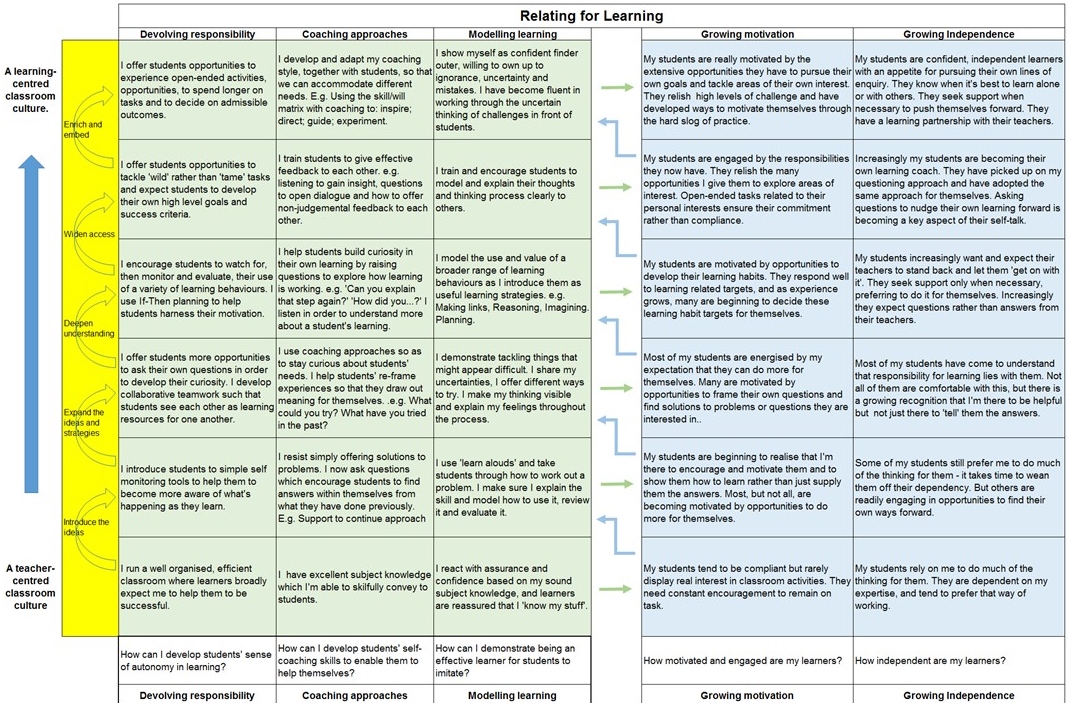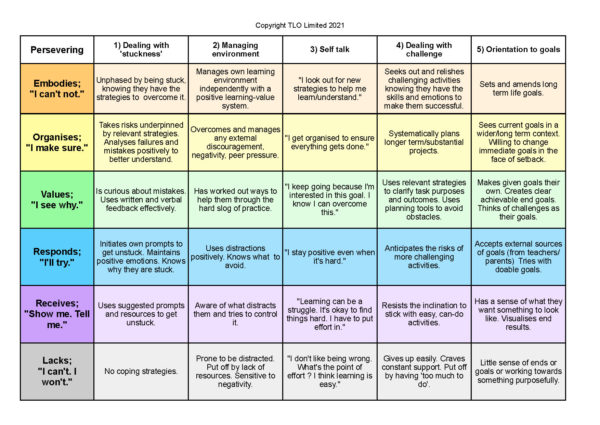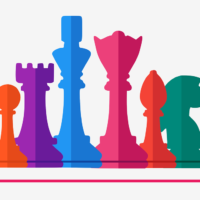Available in both primary and secondary school editions.
In this second phase of the Building Better Learners programme the focus is on using the foundation of learning friendly classrooms to strengthen and build a broader, richer range of learning characteristics. Everything is deeper, harder, richer and so more impactful.
Having completed Phase 1 staff will be eager to..
broaden and improve their skills in the 12 aspects of classroom culture to create richer learning-friendly classroom cultures . . .
…ensure that their students become increasingly disposed to achieve the joy of learning . . .
…broaden the range of learning behaviours that students recognise, discuss, understand and use successfully. . .
…deepen that understanding through the use of deeper behaviour-specific progression charts.
While Phase 1 emphasised shifting classroom culture, all units in Phase 2 are woven around one particular learning behaviour. The hope is that the foundation of learning friendly classroom cultures laid in Phase 1 will now be used to focus on strengthening and building a broader and deeper range of learning characteristics. The Professional Learning Power Game is likely to take a school at least two years to complete and carries the possibility of making a really significant improvement in students’ learning habits.
An overview of the materials
‘The Professional Learning Power Game‘ contains all the key elements needed to deepen the values, language and activities for strengthening and building students’ learning character.
The course has 13 units that can be used in any order and for a range of purposes.
Each unit has 4 sections that look at;
- How the behaviour develops. The Progression Chart. Unpick the meaning of a behaviour, how it develops over time and using the chart to plot where students are now.
- Taking the behaviour into classroom culture. Activities to encourage the behaviour. Offers numerous suggestions to develop a friendly culture and build students’ learning skills.
- Blending the behaviour with content. Dual Focused Lesson ideas. Suggests a series of questions and steps you might use to ensure the development of the behaviour to ensure it claims its place in the curriculum and is designed into lesson/activities to aid understanding.
- Team reflection and planning. Share the impact of your experiments with colleagues and plan what you need to do next.
4 units which deepen the four behaviours introduced in Phase 1
- Putting perseverance into learning
- Putting questioning into learning
- Putting collaboration into learning
- Putting revising into learning
A further 8 units which broaden and deepen students’ learning behaviours
- Putting noticing into learning
- Putting making links into learning
- Putting imagining into learning
- Putting reasoning into learning
- Putting capitalising into learning
- Putting listening into learning
- Putting planning into learning
- Putting meta-learning into learning
And one unit that offers some tools to review and evaluate progress in terms of classroom culture and student learning behaviours. This unit can be used as often as required.
- Reviewing our Progress
Learning behaviours…

..and how they grow.
Tailor the course to your school
Why no recommended order?
A fair question!
Highly effective learners have a wide range of learning dispositions and skills – they play with a full deck of learning cards. But this doesn’t mean all 12 learning behaviours are of equal importance. Perseverance, Questioning, Collaboration and Revising for example, formed the vital bedrock of Phase 1 on which other behaviours can now be successfully grafted. Some behaviours are exercised more frequently in some subjects than in others, so the blend of behaviours essential for being a scientist may differ from the blend for a linguist, or an artist etc. Secondary teachers in particular may well be attracted to the learning behaviours that figure most frequently in their own subject areas.
Equally, the existing learning strengths and weaknesses of your students should inform the decisions you make – if you are aware that Listening, for example, is a weakness that shows up in the majority of your students’ learning profiles, why would you not choose to start there?
The intention is that schools choose their own personalised route through these units in light of their unique circumstances.
Deepen learning behaviours
If you take a hard look at perseverance you’ll notice it’s about keeping going in the face of difficulties; channelling the energy of frustration productively; knowing what a slow and uncertain process learning often is. A mature learner understands that real learning requires effort and persistence, relishes opportunities to struggle with challenge, and believes that with effort they can become a more effective learner. This captures what we want all learners to become so there’s more to it than you might have thought.
The charts in Phase 2 endeavour to pick up this deeper level of detail; take perseverance for example….
Take a look at the chart…
Perseverance is about the way we stick at things even when they are difficult. It’s one of the most useful but neglected learning behaviours. What makes us able to persevere more and more usefully? We think several things come into play here. How you are willing and able to deal with being stuck, how you are able to manage distractions and manage the learning environment, how you relate to a challenge and whether you are influenced by goals whether they be your own or imposed by others. All these things contribute to being able to persevere. And of course there’s your own little voice of self-awareness: what you say to yourself and how this influences your beliefs and values.
Being perseverant grows and builds when it’s nurtured and supported. Furthermore, being perseverant involves gaining control of a range of linked skills and emotions.
The other 11 learning behaviours in phase 2 have their own, richer progression charts. These guide teachers to better understand and coach the richer states and stages of development.
Take a look at how progression in Perseverance might grow across five components.
Download the Perseverance ChartDeepen teaching behaviours
Simple teacher progression charts were introduced in Phase 1 giving teachers a sense of their own journey as a learning power coach. But as we witnessed this development journey we found it was more complex than you might think!
Teacher growth is coupled to student growth
The teacher growth chart is progressive – each step builds on the preceding one, each step needs to be attended to before further ones are attempted. But in making this progression teachers need to consider carefully where their students are as learners – they really do need to;
- start from where students are,
- Rather Than
- from where they themselves want to be.
This is because teachers’ practice will be constrained by their students’ dispositions, skills and understandings of their learning. In Phase 2 you will find broad learner growth charts (shown here in blue) linked to teacher growth charts (green).Teachers are advised to shape their practice one step ahead of their learners’ practice, then wait for their learners to ‘catch up’. Students need time to discern, understand and act on changes the teacher is causing them to make.
A classroom where the teacher is performing at or near the top of their growth trajectory while their learners are languishing near the bottom of their growth trajectories would be a totally inappropriate and ineffective – there’s little point in changing teaching practice if it doesn’t impact on learners’ dispositions. Where learners sit on this ‘blue’ trajectory is a useful indicator of the presence and impact of the ‘green’ teacher interventions. Something’s amiss if there is not a fairly close match.
A delicate combination of teacher development and student progression

Teachers keep a step ahead. Students play catch-up
Support for senior leaders and learning champions
This complementary resource takes a leadership perspective on Phase 2 of developing students’ learning power. It’s designed to offer leaders a view of the strategic concerns that will arise when the school takes on ‘The Professional Learning Power Game‘
It offers some hard questions, think pieces, development frameworks and monitoring and review tools to help leaders:
- feel reassured about the purpose, benefits and frameworks for Phase 2;
- explore important leadership roles when supporting the deepening of Learning Power throughout the school;
- maintain momentum into the future;
- understand significant shifts in ways of working as teachers’ skills develop in the latter stages.
These strategic issues are considered over 5 sections:
- Overview and an outline of the Phase 2 programme for staff
- Key messages of learning power distilled
- Leadership strategies to ensure success including;
- Recognising the real life value of learning behaviours
- Expanding classroom learning cultures
- Reshaping curriculum delivery using a wide range of behaviours
- Expanding the range of learning behaviours used
- Evaluating the schools vision
- Learning from looking
- Carrying the messages to parents
- Keeping an eye on progress
- Where now? What next?
Costs and benefits
‘The Professional Learning Power Game offers material that ensures a deep consolidation of the whole Building Better Learners programme. A benefit to the school and its students for years to come.
.
We’ve borrowed this cost benefit analysis from a school that has been working with learning power for some time. The depth of the learning behaviour charts in Phase 2 gave them far greater insight into learning and how it could be utilised by the curriculum itself. So the various professional learning teams across the school became research teams. Here they didn’t just research and perfect their own practice but took a wider angle look at the curriculum and lesson delivery and how learning behaviours could be built in at curriculum planning level alongside types of retrieval practice and the interleaving content.
Looking at learning behaviour progression influenced how both the curriculum and individual lessons changed. It led teachers to re-evaluate how their subject delivery might be made even more learning and learner focused. Classrooms have become very alive with learning.
Note that any benefit side of this type of analysis will take time to build. However, the different types of benefits provides a useful view of what the school wants to see happen as a result of the staff development efforts. It’s a valuable set of goals.




Comments are closed.